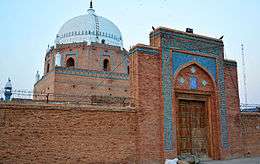Bahauddin Zakariya
| Baha-ud-Din Zakariya بہاؤ الدین زکریا | |
|---|---|
|
| |
| Religion | Islam, specifically the Suhrawardiyya Sufi order |
| Personal | |
| Born |
1170[1] Karor Lal Esan (District Layyah), Punjab |
| Died |
21 December 1262 (aged 91–92)[1] Shrine of Bahauddin Zakariya, Multan, Punjab |
| Senior posting | |
| Based in | Multan, Punjab |
| Title | Hadrat, Sheikh (Ghous-ul-Aalamin) |
| Period in office | 12th/13th century |
| Predecessor | Shahab al-Din Suhrawardi |
| Successor | Various, including Lal Shahbaz Qalander, Fakhr ud din Iraqi, Jalaluddin Rumi and Sayyid Jalaluddin Surkh-Posh Bukhari |
Baha-ud-din Zakariya (Urdu and Persian: بہاؤ الدین زکریا) (1170 – 1262), also spelled as Bahauddin Zakariya, and also known as Baha-ul-Haq and Bahauddin Zakariya Multani, was a Sufi of Suhrawardiyya order (tariqa).[1] from Kot Kehror (Karor Lal Esan), a town of the Layyah District near Multan, Punjab, Pakistan.[2]
Early life
His full name was Abu Muhammad Bahauddin Zakariya. He was from the lineage of Asad Ibn Hashim hence Hashmi.
Sheikh Baha-ud-Din Zakariya was born at Kot Kehror (Karor Lal Esan), a town of the Layyah District near Multan, Punjab, Pakistan, around 1170. His grandfather Shah Kamaluddin Ali Shah Qureshi arrived in Multan from Mecca en route to Khwarezm where he stayed for a short while.[2]
In Tariqat, he was the disciple of renowned Sufi master Shaikh Shahab al-Din Abu Hafs Umar Suhrawardi who awarded him Khilafat in Baghdad and then assigned his khalipha (chief disciple) in the Multan area.[1]
For fifteen years, he travelled to different cities in order to preach Islam and finally settled in Multan in 1222.[3]
Writings
- Awrad-e-Shaikhush Shuyukh: Al-Awrad : Awrad-e-Suhrawardy
( اوراد شيخ الشيوخ : الاوراد : اوراد سهروردي)
Shrine
Coordinates: 30°12′02″N 71°28′35″E / 30.20056°N 71.47639°E

Baha-ud-Din Zakariya died in 1268 and his mausoleum (Darbar) is located in Multan. The mausoleum is a square of 51 ft 9 in (15.77 m), measured internally. Above this is an octagon, about half the height of the square, which is surmounted by a hemispherical dome. The mausoleum was almost completely ruined during the Siege of Multan in 1848 by the British, but was soon afterward restored by the Muslims.[4][3]
Many pilgrims visit his shrine at the time of his urs from different parts of Pakistan and beyond.[5][6]
Part of a series on Islam Sufism |
|---|
|
|
List of sufis |
|
|
Commemorative honors
- Bahauddin Zakaria Express train is named after him, which runs between Karachi and Multan.[7]
- Bahauddin Zakariya University located in Multan is named after him which is the largest institution in Southern Punjab.[1]
Sufi order
Baha-ud-Din Zakariya belonged to the Suhrawardiyya Sufi order, which was well known in the Mamluk Sultanate of India. He was one of the disciples of Sheikh ul-Sheiyukh Shahabuddin Suhrawardy and Multan had come to be known as "Baghdad of the East" after he settled here. It is mentioned in the following couplet of Bahaul Haq in Persian :
Multan ma ba jannat a'la barabara
Ahista pa ba-nah ke malik sajda mi kunad.
(Multan of ours is comparable to the great Paradise, Tread slowly, the angels are paying obeisance here.)
References
- 1 2 3 4 5 Profile of Bahauddin Zakariya on storyofpakistan.com website Updated 3 January 2005, Retrieved 15 February 2018
- 1 2 Hazrat Sheikh Bahauddin Zakariya Multani. Alahazrat.net
- 1 2 Mausoleum of Shah Bahauddin Zakariya "Multan City Online", Updated 2005, Retrieved 16 February 2018
- ↑ University of Calcutta (1891). Calcutta review. University of Calcutta. p. 251. Retrieved 10 January 2011. This section uses content copied verbatim from this source, which is public domain.
- ↑ Dawn Staff Correspondent (27 October 2017). "Urs of Bahauddin Zakariya begins in Multan". Dawn (newspaper). Retrieved 15 February 2018.
- ↑ "Bahauddin Zakariya Urs celebrations begin in Multan". Pakistan Today (newspaper). 28 November 2014. Retrieved 15 February 2018.
- ↑ Aamir Majeed (5 November 2016). "Fareed Express Train collision report to be submitted to minister on Monday". Pakistan Today (newspaper). Retrieved 15 February 2018.